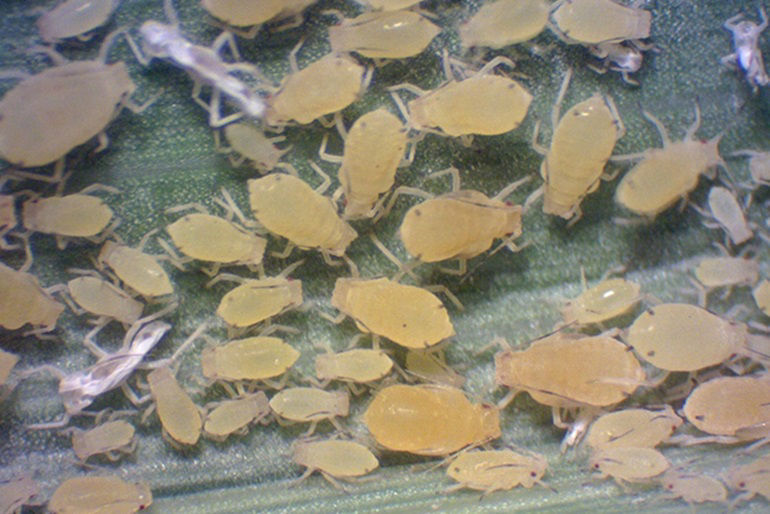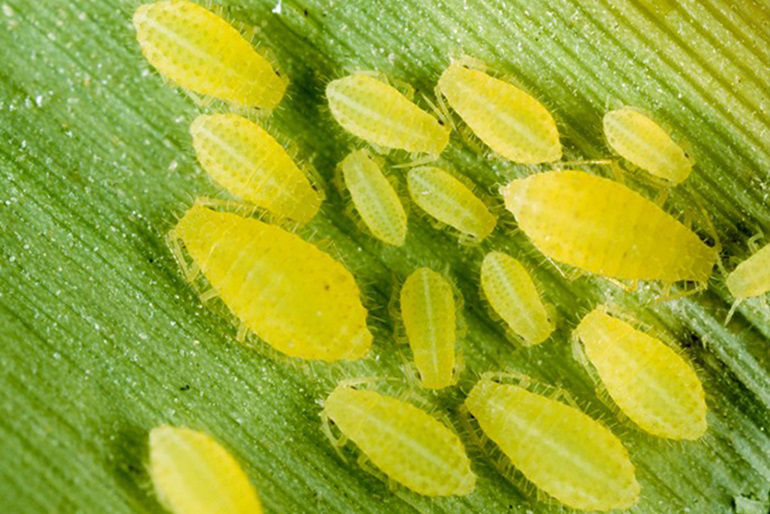Sugarcane Aphids Pose Growing Threat to Sorghum
December 19, 2018


Grain sorghum farmers managing insect pests are familiar with the threat of aphid infestations: greenbugs, yellow sugarcane aphid and corn leaf aphid. Now a new aphid pest – the white sugarcane aphid (Melanaphis sacchari) – is creating havoc for many sorghum farmers, who are increasingly seeing profit-robbing infestations in their fields.
Since the new sorghum pest entered the U.S. from Mexico in 2012, it has emerged into the most troublesome insect pest for grain sorghum farmers in Texas, Oklahoma and southern states. The sugarcane aphid has quickly moved north into Kansas and neighboring states.
Identification and Lifecycle
Often referred to as the white aphid, the sugarcane aphid appears pale yellow, tan or gray in color. Properly distinguishing the white sugarcane aphid from the yellow sugarcane aphid is essential to farmers because management options and insecticides vary between the two insects. Sugarcane aphids are tiny, and you’ll need a magnifying glass to identify the black cornicles on the aphid’s back end and black antennae tips. The aphids usually cluster on the bottom side of sorghum leaves along the midrib. Sugarcane aphids also resemble greenbugs.
All sugarcane aphids are female, so each female has the capacity to asexually produce up to three offspring per day. Within five days, these newly born aphids become adults that survive for approximately 28 days. For example, Texas A&M research conducted near Corpus Christi showed that an infestation of 50 sugarcane aphids per leaf increased to 500 per leaf in two weeks.
As adults, sugarcane aphids grow wings and migrate by wind. When wind currents encourage dispersal, they can quickly move long distances from field to field to infest sorghum crops.
Host plants that allow sugarcane aphids to survive and increase populations include sorghum genotypes such as grain sorghum, Johnsongrass, shattercane and sorghum used for forage. Although sugarcane aphids may be blown into crops such as corn, soybeans, cotton and wheat, they’ve not yet shown economic significance in those crops.
Crop Damage
The “honeydew” secreted by sugarcane aphids occurs when the insect’s piercing mouthparts suck out plant sugars and water. If infestations are not detected within a week, they can cause young sorghum plants to wilt and die. Often, black soot mold can grow on honeydew deposited on the sorghum leaves. The mold obstructs sunlight, decreasing photosynthesis and the plant’s ability to produce sugars.
Grain sorghum yield losses from sugarcane aphids can reach up to 100 percent if left uncontrolled during the pre-boot growth stage (head enclosed in the swollen flag leaf sheath) and 67 percent during heading. Honeydew can “gum up” combines and disrupt harvesting when heavy aphid populations infest the upper leaves or sorghum head. Lodging may also occur.
Scouting
After sorghum emergence, begin scouting for sugarcane aphids weekly. Scout at least two times per week if aphids are detected, as populations can rapidly escalate. Look for the shiny, sticky honeydew on upper sides of leaves and aphid colonies on lower sides of leaves.
Because the white sugarcane aphid is a relatively new insect pest in sorghum and easily confused with yellow sugarcane aphids, it’s often recommended to take samples and share with your University Extension experts.
Scout at least four locations of 15 to 20 plants within a field and count the number of aphids on leaves to determine if populations have reached economic thresholds for an insecticide treatment. Economic thresholds for insecticide application vary by region, so consult Extension recommendations for your area.
Best Management Practices to Control Sugarcane Aphids in Sorghum
The best approach to managing sugarcane aphids in sorghum is prevention. For a comprehensive list of best management practices (BMPs), see the “Defense Against the Sugarcane Aphid” publication from the Sorghum Checkoff.
In no-till or limited-till situations, sugarcane aphids and other insect pests may overwinter in some regions. Season-long weed control helps prevent sugarcane aphids from causing crop damage and will help improve effectiveness of in-season insecticide treatments. Taking out existing vegetation with burndown and preplant residual herbicides can control host weeds such as Johnsongrass and wild sorghum and help prevent insects from feeding on young seedlings.
Select grain sorghum hybrids that have some tolerance to sugarcane aphids. Most commercial hybrids with partial tolerance can resist higher aphid populations while not reducing yield - or at least slow infestation numbers compared to susceptible hybrids.
For recommendations about sugarcane aphid-resistant hybrids, ask your local seed dealer, check the Sorghum Checkoff website or look for your state university Extension recommendations. For example, in a recent guide, Louisiana State University provides a list of sugarcane aphid-resistant sorghum hybrids.
The Sorghum Checkoff also recommends planting sorghum seeds with an insecticide seed treatment, which may provide up to 40 days of early season protection against sugarcane aphids. Seed treatment options include Gaucho® 600 from Bayer
Controlling sugarcane aphids should include a management system that facilitates beneficial insects, including pollinators, as well as appropriate timing of insecticides.
Sivanto® Prime insecticide from Bayer is a viable choice to control sugarcane aphids in grain sorghum and other sorghum forage crop insect pests such as yellow sugarcane aphids and corn leaf aphids.*
The first member of a newly created Insect Resistance Action Committee (IRAC) subgroup 4D chemical class of insecticides (butenolides), Sivanto offers a new insect control option to help manage yield-damaging insects as well as insecticide resistance.
Sivanto Prime provides up to 21-day control, is easy on beneficial insects such as ladybugs that help control sugarcane aphids and other sorghum insect predators, and has a good EPA safety profile for humans and honey bees when used as directed. Check with your ag chemical retailer and review the product label to determine if Sivanto prime is labeled for grain sorghum in your state.
Visit our insecticide section for information about insect control options from Bayer to help sorghum growers maximize yields and protect their crops, or contact your local Bayer representative.
*Sugarcane aphid control is sorghum was limited by the EPA in September of 2015 when sulfoxaflor insecticides were removed from the market due to concerns surrounding its safety profile for honey bees. For 2016 a limited approval for 10 states to resume using sulfoxaflor insecticides was granted by the EPA for 10 states
Before using an insecticide, please read the entire label for the best possible results and to confirm the product is effective on the pests you wish to control. Not every product is suitable for every situation, and the use of the correct application technique will ensure the best results. Sivanto Prime is a Restricted Use Pesticide. Sivanto Prime, Guacho 600, Bayer, and the Bayer Cross are all registered trademarks of Bayer.